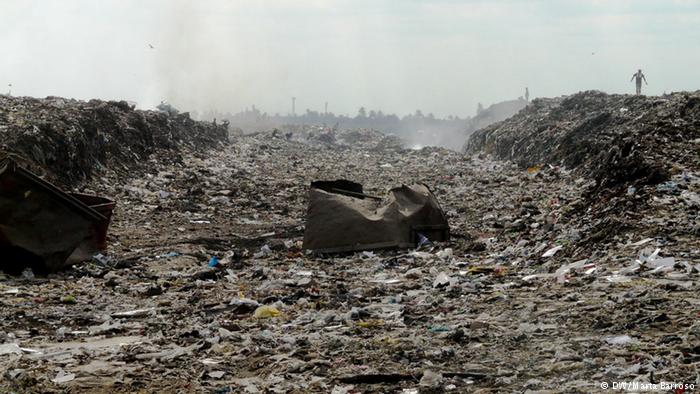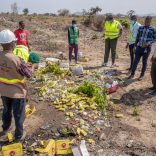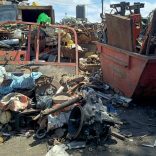Mozambique: Road blocked after police shoot two drivers in wrong vehicle
Hulene: Belatedly, families are moved away from rubbish dump – Mozambique

Hulene. File photo: Marta Barroso / Deutsche Welle
The Mozambican authorities are finally transferring all the families still living in the shadow of the gigantic rubbish tip in the neighbourhood of Hulene to safer areas.
This transfer is happening in the aftermath of the pre-dawn tragedy on Monday, in which, under the pressure of heavy rains, part of the rubbish dump collapsed on top of seven houses, killing 17 people.
A government team, headed by the Minister of State Administration, Carmelita Namashalua, visited Hulene on Monday, and guaranteed that the rescue work will continue at the dump, until it is certain that there are no more survivors, and no more bodies to be recovered.
The 32 families still living in front of the towering mountain of rubbish, and at risk if there is any further collapse, are being moved to an accommodation centre in the Ferroviario neighbourhood, Namashalua said.
1kg de arroz, um sabonete, um cobertor, algumas peças de roupas FAZEM TODA A DIFERENÇA
Por favor AJUDEM #PrayForHulene #AmigosdoTwitter— ? (@kiyaraDenise) February 20, 2018
Dear @FNyusi,
There's a time when you delegate, however this situation is different, #PrayForHulene is the call of duty. Join #HelpForHulene and let's do something to help the victims. It's simple to enlist, show your self and make the difference.
Greetings #AmigosDoTwitter— Ivando Tembe (@zamurano) February 20, 2018
The Municipal Police are in Hulene to ensure that the transfer goes smoothly. They are accompanied by teams from the fire brigade, the Red Cross, and the country’s relief agency, the National Disaster Management Institute (INGC), all involved in persuading people to leave for the Ferroviario centre. So far there is no sign of resistance.

The Mayor of Maputo, David Simango, told reporters that the Municipal Council “accepts responsibility for everything that happened”, but did not want to answer questions about the Council’s negligence.
“I would like to ask everyone to concentrate on rescuing people, instead of debating the rubbish dump, said Simango, cited in Tuesday’s issue of the independent newssheet “Mediafax”.
“We all know that the rubbish dump should have been transferred, we all know that there is a landfill under construction”, he said. “But discussing this, when the bodies are still warm, gives the idea that we want to evade our responsibilities”.
“I don’t want to get into this debate about the rubbish dump and the landfill “, he continued , stating that this was “out of respect for the victims. The people who have lost loved ones don’t want to discuss this”.
He would eventually answer questions about the dump, he promised, but “for the next three or four days I will concentrate on burying these victims, and consoling the people who are in hospital. Let me concentrate on that”.
When journalists pressed, he said “I don’t want to discuss whether there was negligence or not. I prefer to say that we are responsible for what happened, and we accept that”.
But Simango cannot escape from his own commitment, given almost five years ago, to close the Hulene rubbish dump. This was one of the planks in his campaign for re-election as mayor in the 2013 municipal elections.
The Hulene dump is a menace to public health, not only because of the threat that piles of garbage 50 metres or so high might collapse, but because seepage from the dump endangers the water table, and the constant fires on the dump give off toxic fumes, causing respiratory problems. The dump is also infested with insect pests such as flies, mosquitoes and cockroaches.
When Simango promised to close the dump, he announced that a site had been identified for a new, modern landfill, in Matlemele, in the neighbouring city of Matola. The Ministry of Land, Environment and Rural Development is backing this project which should ensure safe disposal of Maputo and Matola garbage for the next 25 years.
The initial projection was that the Matlemele landfill would begin operations in late 205 or early 2016. But two years later, the landfill is not operating, and the Hulene dump is still open.
Money does not seem to be a problem. In 2014, the Maputo City director of salubrity, Joao Mucavele, said 40 million dollars was available for the project. The real difficulty was one that has recurred repeatedly to frustrate Mozambican development projects – people have illegally moved into the area reserved for the landfill and have built houses there.
Matola Municipal Council could have removed the squatters but has not done so. “We’ve mobilised the money”, said Mucavele. “We are solving the question of the people living inside the area earmarked for the landfill”.
Years have passed, and there is little sign of progress. “We are working to close the rubbish dump”, the Maputo City Councillor for Health and Social Welfare, Yolanda Manuel, told reporters. The Monday collapse “showed us we have to pick up the pace, but our work is continuing. Indeed, it never stopped”.
But when asked what precisely had been done, Manuel said she could not go into details. “I can guarantee that the work to close the dump is at an advanced stage”, she claimed, adding that many of the people who had lived in the vicinity of the dump had been resettled in Chiango (on the northern outskirts of Maputo).
But she admitted that many of those resettled, had returned to live in the dangerous area in the shadow of the Hulene dump (presumably because it is much nearer central Maputo than Chiango is).
So once again the Council knew full well that people were living in highly dangerous areas, but took no measures to force them to leave – with tragic results.













Leave a Reply
Be the First to Comment!
You must be logged in to post a comment.
You must be logged in to post a comment.